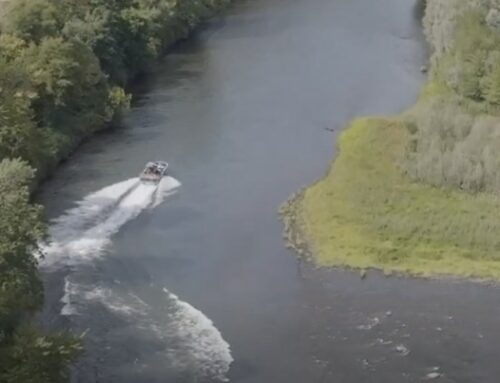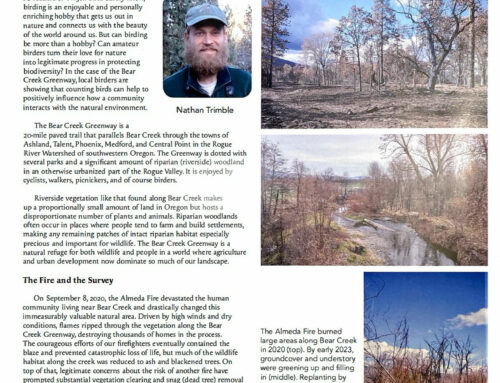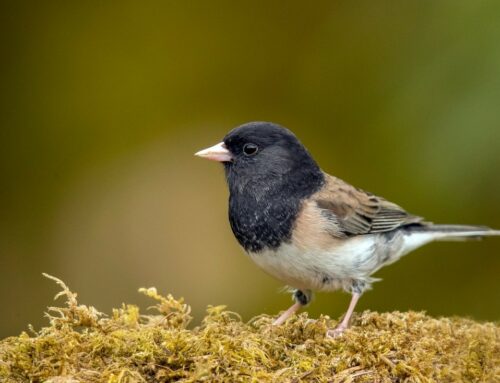To: The Ashland City Council, Mayor John Stromberg
CC: Paula Brown, Public Works Director; Michael Black, Director of Parks and Recreation
From: Pepper Trail, Rogue Valley Audubon Society
Kristi Mergenthaler, Southern Oregon Land Conservancy
Date: March 17, 2020
Subject: Public Access to, and Management of, the Imperatrice Property
The Rogue Valley Audubon Society (RVAS) and the Southern Oregon Land Conservancy (SOLC) have a long and well-documented history of involvement with the City of Ashland’s Imperatrice Property. In 2014, the presence of the largest nesting colony of Grasshopper Sparrows known in western Oregon was discovered on the property by naturalist Frank Lospalluto, who is associated with both our organizations. The Grasshopper Sparrow is identified as a “Species of Greatest Conservation Need” by the Oregon Department of Fish and Wildlife and is in steep decline throughout its range. RVAS paid for formal Grasshopper Sparrow surveys in 2016 (conducted by Lospalluto), resulting in a report by the Klamath Bird Observatory. This documented the presence of 32 singing males on the Imperatrice in 2016.
Informal botanical surveys also discovered the presence of two rare plants on the Imperatrice, California macrophylla and Ranunculus austro-oreganus. These were further documented by the “Biological Assessment, Imperatrice Property, City of Ashland, Oregon,” prepared by Pacific Crest Consulting in August 2017, which also confirmed the continued health of the Grasshopper Sparrow population.
Based on the notable biological resources of the Imperatrice, RVAS, SOLC, and the Siskiyou Chapter Native Plant Society of Oregon (NPSO) have conducted public field trips in the property, and our members regularly visit the area. Therefore, we were shocked to find on March 6 that the access gate is locked and the public is now denied access to this City of Ashland property. We have since found that the lower portion of the property has been leased to the Land Manatee Foundation (LMF). In the words of the lease:
This lease is specifically available for approximately 265 pastoral irrigatable acres below the TID canal on two tax lots (38 1E 32 TL 200 and 38 1E 33 TL 200) and may be available for an additional approximately 224 acres of dry pasture to the north of the TID canal within the remainder of 38 1E 33 TL 200 if appropriate fencing is provided along the canal to the satisfaction of the City in consultation with TID.
The intended use of the property by the Land Manatee Foundation is stated to be “for purposes of operating a restorative and regenerative ranch for cattle and horses.”
The lease was issued pursuant to a “publicly advertised formal Request for Proposals.” While this RFP may have been publicly advertised, we are dismayed that our two organizations were not alerted to this proposed drastic change in the status of the Imperatrice, given our demonstrated interest in the property.
We have two primary concerns: public access and the extent and intensity of grazing.
Public Access. Many Ashland residents have become accustomed to hiking, birding, and observing wildflowers and pollinators in the Imperatrice, which is the only expansive grassland area open to the public in the Rogue Valley. We are disappointed that continued public access to the area above the ditch was not made a condition of the lease and would have strongly advocated for that if we had been made aware of the RFP. We hope that access can be re-opened by discussions between the City of Ashland and the Land Manatee Foundation. At minimum, we request that limited access be allowed for scheduled public field trips organized and led by RVAS, SOLC, NPSO, and similar community groups.
Extent and Intensity of Grazing. We are not necessarily opposed to grazing on the Imperatrice. The irrigated area below the TID ditch has a recent history of grazing, and we do not object to a continuation of grazing in this portion – which is the part of the property currently “specifically available” for grazing under the terms of the lease.
We are, however, concerned about the possibility of grazing being extended above the ditch, as would be allowed by the lease if “appropriate fencing is provided along the canal.” We note that the area potentially subject to grazing above the canal includes the locations of more than half the singing Grasshopper Sparrows documented in the 2016 KBO surveys, and most of the rare plant occurrences. Therefore, we have grave concerns about the ecological impacts of grazing above the ditch. Further, it is not clear from the lease if LMF would be required to enclose the entire “224 acres of dry pasture to the north of the TID canal” since the only specific mention is fencing “along the canal.” Clearly, only complete perimeter fencing should be considered to be “to the satisfaction of the City.”
The Land Manatee Foundation proposes “to use the “Imperatrice” property as a living history-designed ranching conservation program by revitalizing the glory of the land usages in an environmentally sustainable method using integrated authentic traditions to preserve past ranching culture” (lease, Exhibit B). While carefully managed grazing can produce ecological benefits in grasslands (especially those damaged by past over-grazing), we are troubled that the LMF proposal contains no details concerning grazing intensity or timing. The lease proposal contains this statement: “Livestock will be managed by the entity the entire length of time the animals are on the property, and the number of animals accords with a specified habitat management plan as defined by Land Manatee Foundation Ranching Conservation Habitat Management Plan (see attached document for reference) in conjunction with NRCS Prescribed Grazing standards.” We have not found this attachment in the materials on the City website, and so cannot evaluate it, nor is there evidence that the City did so. Thus, we must ask: how many cows and horses will be grazed on the property? When will they be placed on the land, and when removed? This is basic information that is clearly specified on standard grazing leases, for example by the Bureau of Land Management. It appears that the City of Ashland accepted this lease of a property of demonstrated ecological value without a review of a detailed grazing plan. This is a serious failure.
Conclusion. Given the issues identified above, we strongly urge that grazing on the Imperatrice property during 2020 be limited to the area below the TID ditch. Grasshopper Sparrows will be arriving in the Rogue Valley in the second half of April, and establishing territories by early May. Grazing during the nesting period would obviously be highly disruptive for this ground-nesting species. During this first year of the lease, consultation among the City of Ashland, the Land Manatee Foundation, and qualified botanists and ecologists should be conducted to develop a detailed grazing management plan that would meet the LMF’s stated goal of “providing ecological support and ensuring biodiversity.” Only then could an appropriate review be conducted by the City to determine if grazing above the ditch is consistent with preservation of the outstanding ecological values of the Imperatrice. Our organizations will be happy to work with the City and LMF on this grazing management plan.
We understand that this is a particularly busy time for city officials and staff, as you respond to the ever-expanding effects of the coronavirus crisis. Nevertheless, given the possibility of livestock soon being turned out on the Imperatrice property, we felt it was important to register our concerns now. We look forward to further discussions when time allows.
Respectfully,
Pepper Trail; email: ptrail@ashlandnet.net
Kristi Mergenthaler; email: kristi@landconserve.org







Leave A Comment
You must be logged in to post a comment.